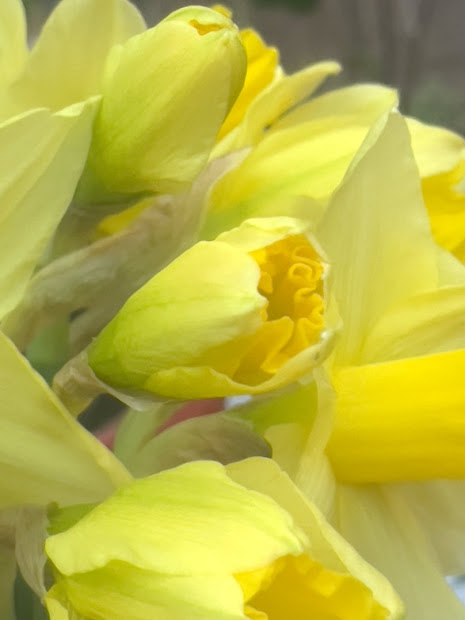Daffodils
– Day 6
Robert
Herrick (1591-1674) wrote the following poem in 1648.
To Daffodils
Fair Daffodils, we
weep to see
You haste away so
soon;
As yet the
early-rising sun
Has not attain’d his
noon.
Stay, stay,
Until the hasting day
Has run
But to the even-song;
And, having pray’d
together, we
Will go with you
along.
We have short time to
stay, as you,
We have as short a
spring;
As quick a growth to
meet decay,
As you, or anything.
We die
As your hours do, and
dry
Away,
Like to the summer’s rain;
Or as the pearls of
morning’s dew,
Ne’er to be found again.
In 1986 the daffodil was adopted by the Marie Curie charity as a symbol of strength, resilience, hope, joy and new beginnings. Marie Curie is the UK’s leading end of life charity. The annual Great Daffodil Appeal occurs in March and each daffodil worn represents a donation to the charity.
There are several hospices across the country and Marie Curie nurses also attend terminally ill patients in their own homes. My sister’s nurse made her last days full of laughter and Beryl died with a smile on her lips.
The American Cancer Society, the Cancer Society New Zealand the Canadian Cancer Society, Cancer Council of Australia all use the yellow cheerfulness of the daffodil to symbolise their campaigns.Maria Salomea Skłodowska (1867-1934) was born in the Kingdom of Poland, then part of the Russian Empire, in Warsaw. She studied at Warsaw University and then later in Paris, where she subsequently conducted her scientific research. She married the French physicist Pierre Curie and it is by the name Marie Curie that she is remembered. In 1903, with her husband and the physicist, Henri Becquerel, she shared the Nobel Prize for Physics for pioneering work in the development of what she called the theory of ‘radioactivity. She and her husband were the first married couple to win a Nobel Prize.In 19ll, Marie Curie won the Nobel Prize for Chemistry for her discovery of the elements polonium and radium. She remains the only person to have won a Nobel Prize in two sciences. During WWI she developed mobile radiography units for use in field hospitals. It is probable that she died, in 1966, from the effects of radiation exposure, the official diagnosis being aplastic anaemia.







I remember learning today's poem at junior school. On reflection, the theme is not perhaps one I would chose as part of the curriculum for a ten year old.
ReplyDeleteCheers, Gail.
It is rather too sombre for a ten-year-old, quite funereal, in fact.
DeleteI recently saw a film about her life . Such a sad ending for such a talented woman.
ReplyDeleteShe was extraordinary.
DeleteSuch beautiful photos. xx
ReplyDeleteThank you, Joy. x x x
ReplyDeleteA beautiful yet poignant poem, and what an amazing woman Marie Curie was. How sad though that she probably died from the effects of radiation exposure. xxx
ReplyDeleteIt seems so unjust.
DeleteYour daffodils are beautiful.
ReplyDeleteMany thanks for sharing the information about Marie Curie.
All the best Jan
Marie Curie was an incredible woman, particularly at a time when women were often underrated, if not actively ignored.
DeleteThank you for such an inspiring post. Daffodils are surely a flower that inspires hope. We have another half dozen opening now. Yours have turned out splendidly, haven't they?
ReplyDeleteThey have done well. I doubt the garden daffodils will fare so well - the dogs don't notice where they're galloping!
DeleteThey were raised by parents who did not give one whit about defining roles by sex. This environment cannot help but create women who do not accept conventional roles as well.
ReplyDeleteI agree. Look at and develop the talents of every child, regardless of sex.
DeleteBeautiful poem and photos.
ReplyDeleteI'm pleased you like them.
DeleteLovely photos and very interesting info. The Curie family were truly an amazing family!
ReplyDeleteAs we drove to my daughter’s a few days ago, I noticed a huge gathering of daffodils along the grass verge; they must’ve been a very early variety. A very cheery sight indeed!
Some do bloom exceedingly early. There are shows for 'early' and 'late' varieties.
ReplyDeleteHi Janice - some history in the Curie family - I hadn't realised. Hospice nurses/carers/doctors are very special ... my uncle and aunt were helped with outreach workers from the local hospice: in fact the nurse recognised my uncle when his time came ... it might have been the house! But still it made him feel special in his last few days. I'm glad your sister had such a caring end - cheers Hilary
ReplyDeleteIt's a gift to be able to offer comfort and succour to the dying. People working in palliative care aren't sufficiently recognised.
ReplyDelete